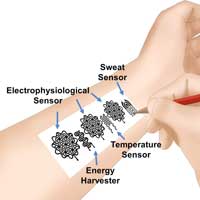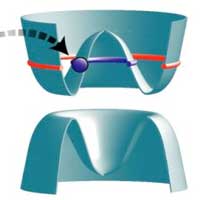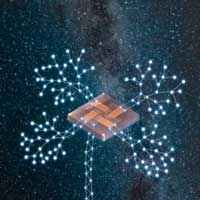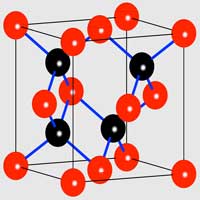 Researchers have invented a technology that can prevent lithium batteries from heating and failing.
Researchers have invented a technology that can prevent lithium batteries from heating and failing.
Tuesday, July 14, 2020
New lithium battery charges faster, reduces risk of device explosions
 Researchers have invented a technology that can prevent lithium batteries from heating and failing.
Researchers have invented a technology that can prevent lithium batteries from heating and failing.
The new tattoo: Drawing electronics on skin
 Engineers discover the possibility of using pencils to draw bioelectronics on human skin.
Engineers discover the possibility of using pencils to draw bioelectronics on human skin.
A new path for electron optics in solid-state systems
 A novel mechanism for electron optics in two-dimensional solid-state systems opens up a route to engineering quantum-optical phenomena in a variety of materials.
A novel mechanism for electron optics in two-dimensional solid-state systems opens up a route to engineering quantum-optical phenomena in a variety of materials.
Customizable smart window technology could improve energy efficiency of buildings
 A customizable smart window harnesses and manipulates solar power to save energy and cut costs.
A customizable smart window harnesses and manipulates solar power to save energy and cut costs.
Spray-drying to produce MOFs and COFs in industrial applications
 MOFs and COFs are porous materials with a broad range of applications, such as gas storage, CO2 capture or drug delivery. Researchers have demonstrated that spray-drying is a suitable method for producing this kind of materials.
MOFs and COFs are porous materials with a broad range of applications, such as gas storage, CO2 capture or drug delivery. Researchers have demonstrated that spray-drying is a suitable method for producing this kind of materials.
Tale of the tape: Sticky bits make better batteries
 Using techniques similar to those they employed to develop laser-induced graphene, scientists turned adhesive tape into a silicon oxide film that replaces troublesome anodes in lithium metal batteries.
Using techniques similar to those they employed to develop laser-induced graphene, scientists turned adhesive tape into a silicon oxide film that replaces troublesome anodes in lithium metal batteries.
Nanoelectronics learn the same way as the human brain
 For the very first time, scientists have successfully imitated the functioning of brain neurons using semiconductor materials.
For the very first time, scientists have successfully imitated the functioning of brain neurons using semiconductor materials.
Exchange bias in van der Waals heterostructures
 This phenomenon has a number of applications in magnetic sensors and magnetic reading heads, which, however, have not been reported in van der Waals heterostructures before.
This phenomenon has a number of applications in magnetic sensors and magnetic reading heads, which, however, have not been reported in van der Waals heterostructures before.
Electrons line dance in a superconductor
 Scientists have confirmed a long-standing theoretical prediction for high-temperature superconductors. Different states of matter make superconductivity possible. One of those theorized states of matter is called a pair density wave. The scientists confirmed pair density waves using advanced microscopic imaging techniques.
Scientists have confirmed a long-standing theoretical prediction for high-temperature superconductors. Different states of matter make superconductivity possible. One of those theorized states of matter is called a pair density wave. The scientists confirmed pair density waves using advanced microscopic imaging techniques.
Hammer-on technique for atomic vibrations in a crystal
 Vibrations of atoms in a crystal of the semiconductor gallium arsenide are impulsively shifted to a higher frequency by an optically excited electric current. The related change in the spatial distribution of charge between gallium and arsenic atoms acts back on their motions via electric interactions.
Vibrations of atoms in a crystal of the semiconductor gallium arsenide are impulsively shifted to a higher frequency by an optically excited electric current. The related change in the spatial distribution of charge between gallium and arsenic atoms acts back on their motions via electric interactions.
Molecularly thin interface between polymers for efficient CO2 capture membrane
 Researchers have discovered the highly selective separation of CO2 over nitrogen in composite membranes with ultrathin layers with selectivity governed by the molecularly thin interface formed between polymers.
Researchers have discovered the highly selective separation of CO2 over nitrogen in composite membranes with ultrathin layers with selectivity governed by the molecularly thin interface formed between polymers.
Subscribe to:
Posts (Atom)
